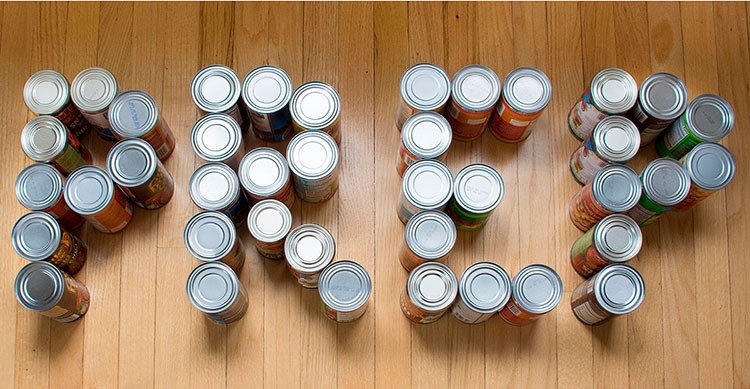
Prepper food is right there in the top 3 critical areas to stock: beans, bullets, and bandages. Of course, “food” in that mantra has to include water, arguably the single most important item to stock. We are going to leave water out of this article, however. Prepper “food” here means anything you can eat, not anything you can drink.
The three most common categories of prepper food include canned goods, pantry staples, and freeze-dried foods.
The need to stock food is obvious – we need it to live. However, there are less dire reasons to have a healthy stock of food stashed away. We’ve seen food shortages, supply chain disruptions, and grocery inflation. Those shaping to be up annual (at a minimum) experiences. Toss in the possibility of a failed state or societal collapse, and food storage suddenly becomes one of the single biggest factors that determines our likelihood of survival.
The more you dig into food storage though, the more confusing things seem to get. Food rots, right? Then there are shelf lives. What foods should you store? What stores the longest? What’s the most cost-effective food to store? How do you safely store food long term?
If you’re just starting out looking at long-term food storage. Take a deep breath. You don’t have to answer every question to get started. In fact, for most people, just expanding existing foods already in the house will add some level of reassurance.
This article is not intended to cover the full scope of prepper foods. Nor is it intended to be a comprehensive guide. This article covers the most basic categories of foods that most preppers keep stored for short to long-term emergencies.
I’ll cover the basic groupings of food types and I’ll also include some frequently asked questions that newer preppers are still bound to have.
The first place to start is also the easiest place to start…
Foods You Already Eat
One of the first things you should keep in mind as you build your prepper food stock is to purchase foods you already eat. Don’t go out thinking you’re suddenly going to like curry dishes after disaster strikes if you’ve always hated them before.
The primary reason for buying more of what you already eat is simple – you know the food will get eaten. There is nothing worse than spending good money on canned food, pasta, or any other food product only to watch it sit and eventually go bad and get tossed in the garbage. That’s a waste of time, money, and resources!
There are more practical reasons for starting with food you already eat:
- It helps reduce the odds you find yourself running out of a food item you eat frequently.
- They are easy to buy – just add a few more of what you’re already buying when you go to the grocery store.
- For short term emergencies, you can keep eating the foods you are already accustomed to cooking and eating.
Keep buying these foods right up to the point that you can no longer eat them fast enough to keep them within the expiration date. Expiration dates often have little meaning when it comes to edibility of the food, but you can use them more as a guide, a “best buy” date if you will.
Rotate stock to make sure everything gets eaten in the order in which it was purchased. First in is first out.
Given that general recommendation, lets now look at 3 types of prepper foods that are centered more around long-term storage, foods that you can use to “beef” up your supplies for prolonged SHTF scenarios.
3 Types of Prepper Food
Entire books have been written on food storage for preppers, and I’ll mention some at the end of the article. As I stated, this article isn’t going to cover everything. It can’t. Instead we’re focusing on the most common prepper foods that people use to extend their food storage beyond a standard kitchen pantry.
1 – Canned Goods
According to the USDA, canned foods that are high in acid (think tomato-based foods) will stay in good condition for up to 18 months. Low acid foods like meat and vegetables will stay in great condition for 2-5 years. This assumes the cans are kept in a cool, dry space and are free from dents, swelling, or rust.
That’s the general guidelines for keeping the food in top condition, but as for edibility, the food in well-stored cans can be kept good for a very, very long time. Perhaps they won’t taste the same as they would’ve 8 years ago when you bought them, but they should still be edible.
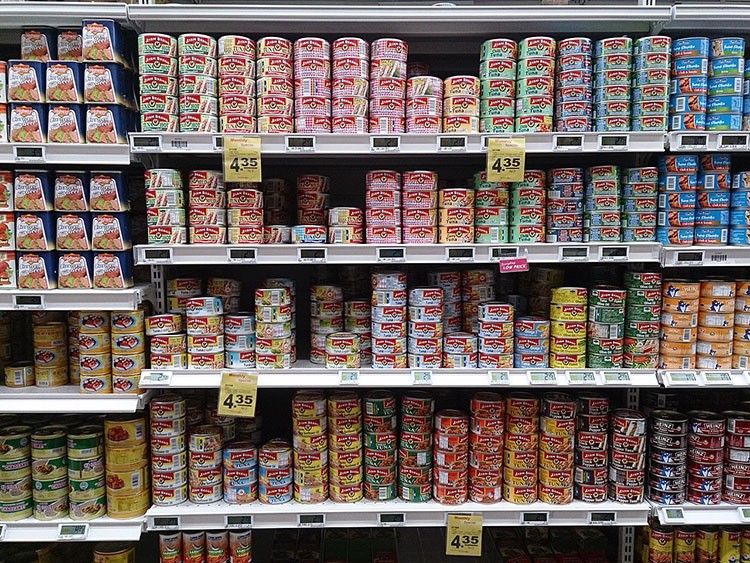
Cans of food make an excellent form of prepper food. They’re easily obtainable, inexpensive, nutritious, don’t destroy OPSEC if seen, and they store well.
Two disadvantages with canned goods are that they’re heavy (ever try hiking with them?), and if you dent them you need to use them ASAP or toss them in the trash. Eating from a dented can is not worth the risk of botulism, particularly during a crisis when it might be impossible to access medical service. Inspect cans when you buy them. it’s not uncommon to find dented cans on the grocery store shelves.
2 – Pantry Staples
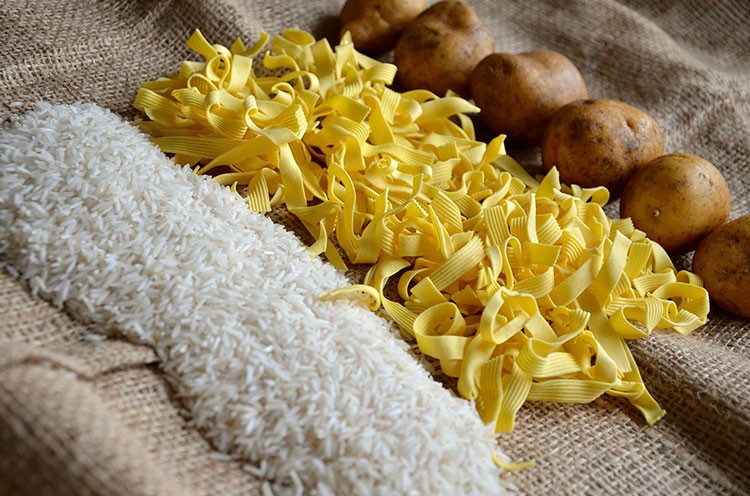
“Pantry staples” – become familiar with that phrase. What it refers to are the building blocks for a massive number of recipes. If you have your pantry staples in order you have what you need to make a wide array of tasty, unique, and nutritious meals. Thankfully, many of these pantry staples serve as great prepper foods as well.
Consider storing the following staples:
- Beans
- Lentils
- Rice
- Sugar
- Salt
- Hard wheat
- Honey
- Potato flakes
Each of these foodstuffs can be stored for years and still be good. Potato flakes are the only item on the list that would have a higher probability of spoilage, but even then, provided you’ve engaged in proper long-term storage (think #10 cans of nitrogen packed dehydrated potato flakes), they can be good for potentially decades.
Storing these foods the right way is critical. You need Mylar bags, O2 absorbers, and some food grade buckets with Gamma seal lids won’t hurt either. For a detailed guide, you can read my article on how to store rice long-term and apply the same steps to other pantry staples.
- [PREMOUNT PACK] Generous 40pcs large size 1 Gallon mylar bags 10x14, 35pcs medium size 1 Quart mylar bags 6x9, 25 small size 1/2 Pint mylar bags 4x6. Includes 60pcs oxygen absorbers 900cc/900ml sealed...
- [PINHOLE RESISTANT NYLON BOTTOM] Resealable mylar bags with 4 strong layers instead of 3. A 4th Nylon layer has been designed and added to the bottom of the bag with only one purpose to resist...
- [UPGRADED 900cc OXYGEN ABSORBERS] Our airtight smell proof packaging include oxygen absorbers with 900cc/900ml of oxygen absorption packed in packs of 5. This will remove oxygen three times as fast as...
- [THICKER LAYER] Maximum total thickness of 12 Mil with 6 mil on each layer. Ensuring longer food storage, prevents light and air permeation. Zip seal for short term and heat seal for long term. Seal...
If you have these staples stocked and have a good spice rack, you could add fresh garden produce or recently trapped game to make a fine meal.
3 – Freeze-Dried Foods (and MREs)
If you don’t like the degree of work and some of the uncertainty that comes with building your food stores, there are commercially available options as well. The two most common are freeze-dried foods and MREs.
Freeze-Dried Foods
This is what I call the “stack it and forget it” approach to long-term food storage. You buy the freeze-dried foods, stack them on a shelf, and with a 25+ year shelf life – you forget it from there. Read my Prepper’s Guide to Freeze-Dried Foods article for more information.
Preparing these foods is just as simple as storing them. All you need to do is add hot water (in most cases) and voila! You have yourself a bowl of fifteen-year-old chicken!
The catch here is the price. There’s no way around it – freeze-dried food is expensive. Making these foods is an energy-intensive process and then there is sealing them in cans or airtight bags and shipping them out. You pay for that production cost and the convenience.
The serious prepper can buy a home freeze dryer as a do-it-yourself tool (follow that link to learn more). These are expensive products but they can save money if you have a lot of foods you want to freeze dry yourself, have particular dietary needs to you need to make your own, or – as some people have done – turn it into a profitable side hustle selling freeze-dried candies, dog treats, etc.
MREs
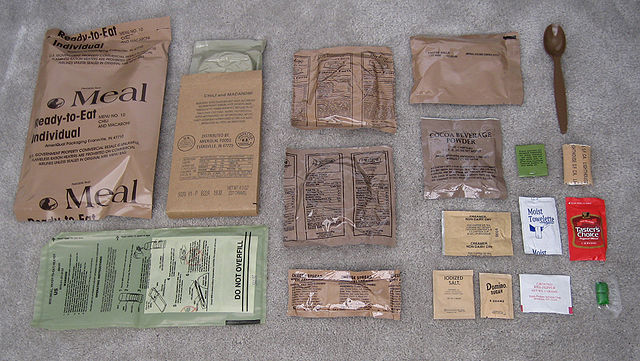
Meals-ready-to-eat (MREs) were created by the military as a means of giving a soldier the ability to have a hot, calorie-rich, nutritious meal that would preserve well in a fighting environment. There are a host of these available out there, and they truly are convenient. All you need to do is add a little cold water to the heater bag, a chemical reaction takes place, and your entrée is warm and ready.
There’s no need for any cookware, external fuel, or any form of camping stove whatsoever. Provided you have the MRE bag in your hands, you’re good to go. I’ve written on the health of them and how long they last before. Just know that MREs are certainly not a prepper food you should bank on eating day after day for months on end should a collapse happen.
The best thing about MREs is that they can be easily tossed into a bug out backpack, emergency stash, or the like and forgotten about. It’s the same “store it and forget it” concept as freeze-dried foods only on a more mobile, personal level.

The downside to MREs include a high price and a shorter shelf life. I’ve also found some of them are straight up disgusting. One of the last MREs I ate was a pasta dish with red sauce. The sauce set up with a plasticky film on it which tasted like… well, like plasticky film.
That being said, I’ve had other ones (e.g., brisket, pancakes, etc.) that are fantastic. Your mileage may vary.
3 Food Storage FAQs
I get asked questions about food storage fairly often, and the bulk of those questions fall along the lines of what foods have the longest shelf life, which foods are the best to stockpile, and how much food should be stored.
1 – What Foods Have the Longest Shelf Life?
We covered this to some degree already. Freeze-dried foods are going to yield some of the longest shelf lives you’ll find. That process of removing as much water as possible is what keeps these foods in top shape with maximum nutritional value intact.
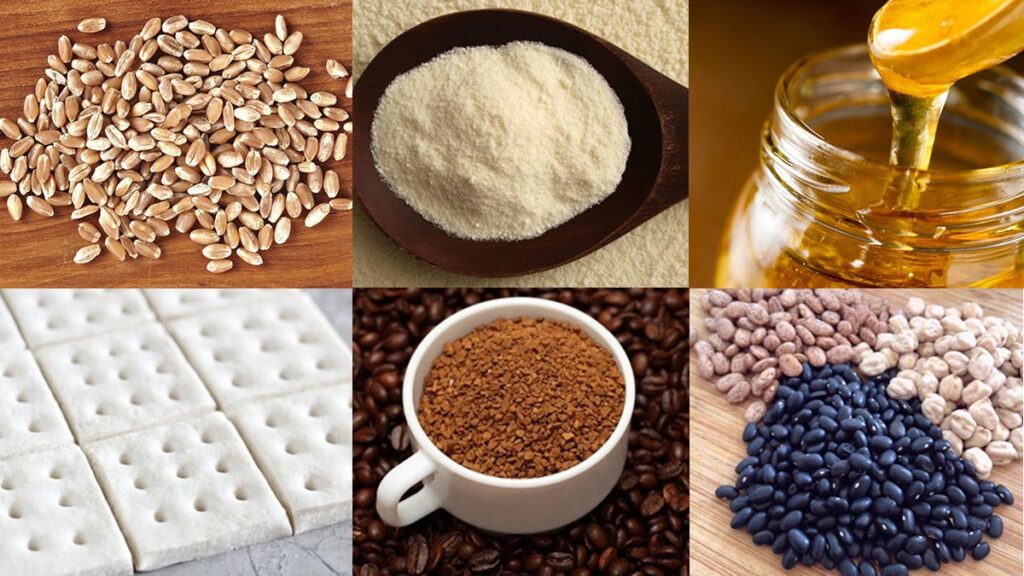
Morgan wrote an entire article answering this question, listing out the different foods with very long shelf lives. Know that these are not necessarily the only foods you’d want to stock, but they keep for a long time and for that reason are great to stock.
What Foods Should I Stockpile?
Coffee! Well, that’s sort of true – if you want need your caffeine fix after the mushroom clouds go up. I’ve also written on long-term coffee storage before, so check that out. Great barter item should the time come!
Practically speaking, I suggest starting with rice and beans. Why? Those two basic foods can provide a whole assortment of essential nutrients. They are readily available. They’re affordable. They are easy to store for the long haul. They last a long time.
Rice can last in the ballpark of 30 years or so if stored correctly. This means you can easily make a few initial purchases and then be set (at least on your rice storage). It’s easily one of the cheapest prepper foods there.
Rice is filling and easy to get ready to eat. You don’t have to worry about the time required for baking bread. With enough time sitting in water, rice is ready to eat (albeit be much tastier if hot water is used). While I most certainly wouldn’t want to live off rice alone, it is a solid staple.
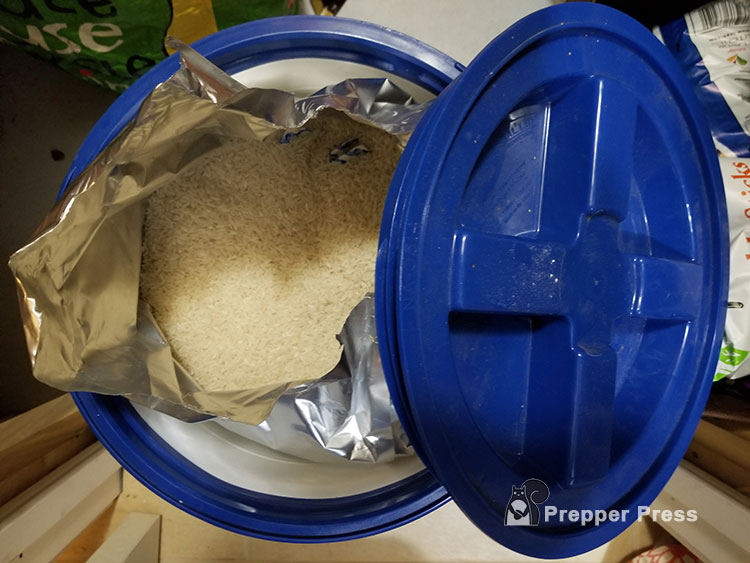
My overall, general food stocking advice.
Get your everyday pantry filled with foods you already eat. Then add some rice, beans, and salt for longer-term storage. Once you’re set there, consider adding some freeze-dried foods. Look for sales to stretch your dollar. Freeze-dried food manufacturers are often running rotating deals. Check our list of bulk survival food deals to shop for bargains.
Look for foods that are nutritious and store long periods of time. Ramen noodles and Twinkies might last a really long time, but they won’t treat your body very well if you’re trying to live off them in a crisis.
Here are some additional food recommendations:
- Rice
- Beans
- Lentils
- Dehydrated potato flakes
- Salt
- Sugar
- Honey
- Hard wheat
- Pasta
- Oats
For pasta, also see my article on long-term pasta storage.
The foods I’ve mentioned here will give you a solid foundation to start from. There are most certainly other foods which could be added, but I’ve found the above to be the staples of most meals out there.
- Manufacted 06/2011
- Insp/Test Date 06/2014
- Shelf life 7 years
- 12 meals per case
If I was looking to add to this list, I would think about adding a small supply of MREs for quick grab-and-go food (such as for a BOB), and maybe some #10 freeze-dried cans of foodstuffs for extreme long-term supply (think of that as an insurance policy of sorts).
How Much Food Should a Prepper Have?
This is a thorny question that a lot of people answer differently. My advice is to always start with a personal threat assessment. Don’t go into prepping blindly. Start small and slowly. Learn as you go. Start with a goal of 3 weeks’ worth of stocked food. Then move to 3 months, 6 months, and if you can make it to a year you’ll be miles and miles ahead of 99% of the population.
One year’s worth of stocked food is the gold standard for most preppers, though there are many who aim even higher than that. It’s daunting to aim for that mark that can quickly lead to somebody becoming overwhelmed and resigning in failure.
Resigning in failure is counterproductive. It’s why I suggest starting with smaller goals and moving up. You achieve a goal, feel a sense of accomplishment and satisfaction, then move on to the next energized and ready.
Prepper Food Summary
The average American has roughly 3 days’ worth of food within their house (so I hear, and believe). Any disaster lasting longer than that will lead to hunger pangs for the majority of America as a result. If you’re just getting into prepping, I think you need to make 2 weeks’ worth of food one of your immediate priorities.
This is relatively easy to do and inexpensive. Once you have that, congratulations! You’ve more food stores than most of the US!
Dave Ramsey, a financial planner who constantly harps on the necessity of having an emergency fund of 3-6 months’ living expenses, argues that much money stowed away will help you to weather most of the financial hiccups life will throw your way.
I see no reason not to apply the same principle to food. Three months’ worth of food will easily help you to ride out most food hiccups thrown your way, whether that be trucker strikes, inflation, job loss, lockdown, or whatever else might come your way.



10 comments
While not exactly a type of food cooking oils comes to mind.Any of the liquid oils stored in glass container last a long time when stored in the dark at an even temperature.
Blocks of lard kept frozen also keep a very long time
Those look like Swift Corned Beef cans in the first pic, at the left of the pic, unpriced. How much are they in the store the pic came from?? I can get them for $2.99 each, but I don’t because I bought 144+ Swift Roast Beef cans (in 6 5-gallon buckets, each bucket holds 24 cans) also for $2.99 each. They “expire” in 2026 I think.
That’s a stock image so I can’t answer your question. 🙂
I remember talking to a retired navy seebe who had worked on building runways and revetments in Saudi Arabia in the mid to late 80’s. One of the things he told me was that they had C rations / K rations that were in the area of 20 or more years old. Other than tasting a bit on the flat order, they were okay ( he said that they didn’t have much choice about it, eat it or else )
Rice, beans, split peas, lentils, steel cut oats, all last for decades in a cool dry dark place. They are about a dollar a pound if you buy in bulk. But if you’re going to stock up on them be sure to have a lot of recipes. Try them in advance to be sure you like them. No one wants to eat plain rice and beans, day after day. There’s a reason you can find ethnic recipes for rice and bean from almost any where in the world–they will keep you alive!
Actually, 10 lb boxes of Quaker Oats old fashioned oatmeal (are these steel cut??) last about 9 years before the bug eggs inside the boxes hatch. White rice, beans, split peas and lentils absolutely do last for decades.
How can you avoid weevils in stored rice? They always seem to appear after time – are they already in the rice waiting to hatch? Do they still exist if and when starved of oxygen in mylar bags? Any advice much appreciated. Thanks for the great articles!
You can freeze the rice for one week after buying it to kill any eggs already there, but if you are then storing it in airtight containers, you shouldn’t have a problem.
Does it matter if you have it in your cabinet unopened for a few months, THEN stick it in the freezer for a week? Or does it have to be done asap…i don’t know how long it was sitting on the shelf before I bought it….
Better to do it after purchasing, but better late than never?